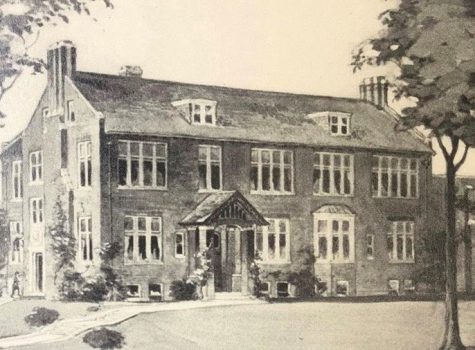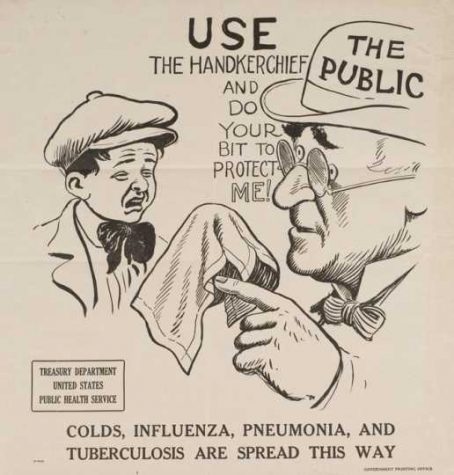[THEN/NOW] Think pandemic closures are new? Look back a century.
September 17, 2020
When thinking of a school, what comes to mind? A campus brimming with students, exploding with activity and the vibrance of life? Or an empty parking lot with a “CLOSED TO VISITORS” stand-up sign blocking the main entrance?
If it was fall 2019, no one would have chosen the latter. But in fall 2020, that is no longer the case.
Yet, throughout the history of St. Paul Academy and Summit School, there have been a handful of times when the school building closed down temporarily like this.
The most similar instances? Now and another notable, similar time: the Influenza of 1918. Although archives and information on SPA during the 1918 outbreak were unavailable, files and information about the outbreak and its effect on schools in the Twin Cities were obtainable. Below are the scenarios of 1918 and 2020.
Juxtapose of SPA in 1918 (left) vs. 2020 (right) made by Elle Chen. Images (left) taken from the SPA Instagram and (right) taken by Mimi Huelster.
1918 Influenza
In March of 1918, the first cases of H1N1 influenza (otherwise known as the “Spanish flu”) were recorded in the United States, remaining mainly in army barracks, such as Camp Funston in Kansas. However, as more and more soldiers across the country were deployed to serve in World War I, the virus followed, with the first waves of the pandemic beginning in large east coast cities such as Boston and New York, and throughout the year gradually made its way towards the Midwest.
On September 27th, 1918, the virus finally arrived in the Twin Cities, reportedly from a man who had come home from a trip to see his son in Camp Dix, New Jersey.
On September 27th, 1918, the virus finally arrived in the Twin Cities, reportedly from a man who had come home from a trip to see his son in Camp Dix, New Jersey. One day later, on the 28th, the University of Minnesota announced that the University hospital would no longer allow new patients or visitors with the discovery of 16 new cases among their nursing staff. The next day, on the 29th, the number of cases at Fort Snelling jumped from 56 to 108. By October 3rd, there were around 100 cases reported in Minneapolis. On October 6th, City Hospital reported 60 serious cases of influenza being treated in their ward.

On October 11th, Minneapolis’s City Health Department ordered the closure of all theaters, churches, dance halls, saloons, and schools, excluding the University of Minnesota. The school closure lasts all but ten days, with the School Board planning on reopening on Monday, the 21st. In retaliation, Minneapolis Health Commissioner Guilford threatened a restraining order against the Board in order to keep schools closed. The University of Minnesota also planned to reopen on the 23rd, but attempts to postpone them failed, as the city of Minneapolis had no jurisdiction over a state school. Superintendent of Schools B. B. Jackson announced that winter vacation would instead be used as a make up time for students affected by school closures. A week later, on Halloween, a tentative date for public school reopening was scheduled for November 11th.
Finally, on November 5th, St. Paul joined Minneapolis in a city-wide closure of public spaces, including schools such as St. Paul Academy and the newly-formed Summit School (SPA as it is now known did not become a reality until 1969). Macalester College also decided to close. Ten days later, both St. Paul and Minneapolis’s ban on public gatherings, along with school closures, lifted. Classes resumed for both cities on November 18th, and the Minneapolis School Board announced that class would remain in session on holidays and two weeks would be added onto the school year in order to make up for lost time. In St. Paul, however, students were still granted their two-week holiday vacation, and the Department of Education granted students their spring break as usual, too, despite the sizable amount of time lost to the lockdown.

While school quickly returned to normal in St. Paul, Minneapolis had to once again order a shut-down of all public schools following a resurgence of influenza cases in children on December 9th. Theater employees were also instructed to ban children under 16 from attending shows due to the risk of infection. While all public schools were closed, private schools were still allowed to have class, prompting accusations of unjust discrimination from Superintendent B. B. Jackson to the Health Department. On Christmas Day, it was announced that public schools will reopen again on December 30th.
Finally, by the end of January, the epidemic more or less subsided in both cities, with the occasional outbreak occurring into late February. Schools reopened for good, and life returned to normal for everyone. The effects of the pandemic, however, were nonetheless devastating. Minneapolis has an excess death rate of 267 deaths per 100,000 people. St. Paul did even worse, with 413 deaths per 100,000 people, and it is estimated that there were 9,000 reported cases and 824 deaths from influenza between September 1st and December 31st. From 1918 to 1919, about 50 million people died from influenza, and out of those 675,000 occurred in the U.S. Up until now, the 1918 pandemic has been the worst pandemic in modern history.

COVID-19
Originated in Wuhan, China, the first cases of COVID-19 was reported on Dec. 31, 2019. Initially viewed as nothing more than a “flu-like” break out in China, by early March 2020, the tables had completely turned as the fatal virus had spread around the world. Officially deemed as a pandemic, COVID-19 felt scary and closer to the community. On March 6, news had spread about the first case of COVID in Ramsey County, Minnesota. As spring break rolled around, COVID was at the forefront of everyone’s thoughts and become the main character of many conversations. Uncertainty about safety, school, sports, and quarantine was inevitable. Preparing for the worst, students were asked to take home all of their school supplies and clear out all personal belongings from lockers. And indeed, the end of the 2019-2020 school year ended online instead of in person. What was supposed to be a relaxing two-week break after the notoriously long “SPA third quarter”, continued on and ended up dragging out for half a year too long.
Since the transition into full distance learning last spring, many students have not yet physically returned to the campus building. Many have been living the same day over and over again. Eat, sleep, google meetings, repeat. And although this lifestyle has created many limitations on daily life, time has still flashed by in the blink of an eye. Now, already into the second week of the 2020-2021 school year, the SPA Upper School is in it’s, hopefully, the final stretch of full-time distance learning. But even after the third and final week of full distance learning come to a close for this school year, things won’t be returning back to normal anytime soon. Starting from late July, Head of School Bryn Roberts, and US Principle Max Delgado, have been sending out lengthy emails about the plan for this school year. Most up to date, Delgado released a statement and schedule for SPA’s plans to transition into an optional hybrid learning starting on Tuesday, September 29. In the email, Delgado wrote, “ US students will be on-campus for two days per week (typically Monday and Tuesday) and then engaged in Distance Learning for two days per week (typically Thursday and Friday). On the Flex Days (typically Wednesday), we will have half of the US students on-campus each week, split into two cohorts: grades 9 and 10; and grades 11 and 12. Whichever cohort is not on campus on a Flex Day will attend their classes via Distance Learning.”
Even if hybrid learning will allow US students to partially return back to school, campus life will still be very different. To further ensure the safety of the community, SPA has not only made decisions to install a new HVAC system and one way only hallways on campus but also reduce classroom sizes, remove harkness tables, reinforce all people on campus to wear PPE at all times, follow social distancing protocols, etc. Any violation of school safety measures will also result in repercussions.
Below are some before and after photos of SPA during COVID-19 times.
On the left is the SPA lunchroom at the beginning of last year during a 9th grade mentor meeting. On the right is the current lunchroom (one of two), set up to ensure the safety of students during the pandemic.
Temporarily closed to visitors, the school compared to last year (left), is much emptier.
To further reinforce social distancing, chairs in common resting and studying areas of the school have been reduced.
All photos taken and Juxtaposes made by Elle Chen. Note: photo on the left of the second juxtapose was taken by the SPA SmugMug and left photo of the third Juxtapose was taken by Clara Garner.
So far looking at the statistics, Minnesota has not yet reached its peak in COVID cases as there is still a constant increase of daily cases. Compared to the H1N1 influenza outbreak in 1918, more than a decade ago, PPE, medical and technological advancements have surely occurred and made the COVID-19 outbreak much more bearable and “as normal as possible” for students, workers, and everyone’s daily lives. But nevertheless, the numbers for COVID related deaths, infections aren’t looking so bright. Since the first case reported at the very end of 2019, there have been a total of 29 million confirmed cases and almost 1 million COVID related deaths. Almost 7 million of total cases and around 198,000 deaths have arisen from the leading contributor of COVID, the US. There have not been steady signs of decrease either.
The new habits and lifestyles formed from what feels like a never-ending cycle of COVID will most likely become the new “normal” for a long time to come. As for SPA and many schools alike, the biggest blows have probably come to the theater, sports, art, music programs, not to mention the social aspects of life in general.